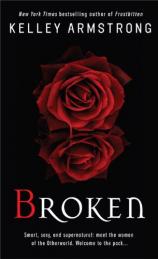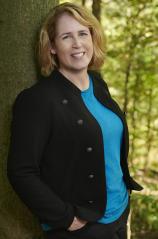Interview: April 28, 2006
April 28, 2006
Kelley Armstrong has penned six novels in the paranormal suspense series The Otherworld, including her latest release, BROKEN. In this interview with Bookreporter.com's contributing writer Steve Hubbard, Armstrong characterizes her protagonist as the embodiment of the struggle between a person's dual natures, and describes the loose plotting process employed with each installment of the series. She also explains why her books are so difficult to categorize and sheds light on why they are told from multiple narrators.
Bookreporter.com: Your work has elements of Horror, Romance, Mystery and Fantasy. How would you define your style of writing?
Kelley Armstrong: Growing up, I "surfed" so many genres --- with both my reading and writing --- that I seem to naturally insert whatever elements work for a given story, without much thought to which genre those elements belong. Today, when someone asks, "What kind of books do you write?" I say paranormal suspense, which seems to encompass the two strongest genre elements. Whether others agree is another matter! When I sold my first book, I think I expected that someone would "decree" that it was genre x (fantasy, horror, romance, etc.) and that would settle the matter. I quickly learned that's not the case. Everyone, from booksellers to readers, has a different opinion of which category they belong in, and I've seen my novels shelved in every bookstore area you mentioned.
BRC: Your physical descriptions of Elena's transformation into a werewolf in BROKEN were incredibly vivid. I could actually feel the pain and dread of the transformation and winced at her fear of putting her unborn child at risk as she let go. Two questions: Does Elena's embodiment of darker forces parallel the struggle in all of us between the 'good' and the 'dark' sides? What did you draw upon to describe so vividly both the emotional and physical repercussions of her transformation?
KA: Elena's initial struggle between her werewolf nature and her human side was, in some ways, reflective of a common "animal nature" versus "higher nature" struggle --- how to balance the side that only cares about the basics of survival (food, protection, sex) with the side that aspires to be a moral and altruistic person. For the transformation scenes, I wanted to be as realistic as I could --- believe me, that's not easy when talking about a person turning into a wolf!
Painful was a must. Plus, for someone like Elena who wasn't raised as a werewolf, I thought there would be some innate fear that the body isn't made to do this and something could go horribly wrong. She thinks she's long past that fear. Then she becomes pregnant. What she's come to accept as natural for herself doesn't necessarily extend to her unborn child, yet she must change or her body will change on its own, which is worse. For the change itself, I drew on my own experiences of childbirth. Yes, it's painful, but then it's over and you have your "reward," which makes it worthwhile. That's how I envisioned the werewolves' physical change --- the transition from discomfort, to pain, to relief and reward.
BRC: How extensive is your knowledge of the Jack the Ripper crime and how much research did you have to undertake to work on this novel?
KA: I've always been interested in Jack the Ripper. It's the ultimate "whodunit." A few years ago, I jotted down the idea of the missing From Hell letter, thinking "what if it really was 'from hell.'" That's not the story I eventually used for BROKEN, but it was the impetus, along with a rumor I'd read that the letter wound up in a private collection in Canada. When it came to writing the book, I knew all the basics, but had to research details.
BRC: When writing BROKEN, did you have a clearly outlined story in advance or did it develop as you wrote it? Did anything surprise you or unexpectedly find its way onto the page as you wrote?
KA: I did have a full outline, but as often happens after I started writing, I changed my mind on a few key points. It seems that I can pre-plot all I want, but it's only once I'm immersed in the story that I really see what will work and what won't, as well as see other possibilities that hadn't occurred to me in the outline process. One thing that often surprises me is new characters. Sometimes I'll plan for a new character to play a major role...but after I "meet" that character --- by creating them on the page and giving them a voice --- I decide they aren't interesting enough to play such a large role, which then requires reworking the outline! The reverse happens just as often --- a supposedly minor character takes on a greater role. In BROKEN, for example, the new vampire, Zoe, only had one appearance in the outline. After I brought her "on-stage," I saw her as a more interesting character than I'd envisioned, so she played a much larger role.
BRC: In the science fiction/fantasy genre, strong female characters are beginning to become more popular but they still are overshadowed by the archetypal male characters, even by female writers. Was it a conscious decision for you to have your main character be a female? Also, what are some of the difficulties/differences you've found when writing female and male characters?
KA: It was more of a natural decision than a conscious one. With first person narrative, I'm more comfortable writing it from a woman's point of view. I've always been wary of taking on the "voice" of someone too different from myself --- in gender, age, socio-economic background, etc. I've experimented more in the last few years, but when I started this series, I didn't consider using a male voice. I've done it since --- with other works --- but it's still more difficult in first person. Third person is much easier. I have no problem doing male characters in third person. One thing I am aware of, when creating strong female characters, is to avoid the trap of making my women seem stronger by weakening the men. I try to make the men just as strong in their way, and just as three-dimensional, putting as much work into the main male characters as I do with my narrators.
BRC: You started with two novels about the werewolf Elena, then switched to witch Paige Winterbourne for the next two. Will we be seeing more from Elena and her companions in the future, or will you be returning to Paige? Or will you introduce readers to a new character to drive the story?
KA: Elena will likely return, though not any time soon. After BROKEN, she'll return to secondary-character status for a while. That's how I keep myself interested in the series, which is critically important for me. I don't want to write about one character until I'm sick of her. I'd rather write a book or two with one narrator, then move on while I'm still interested enough to look forward to the time I can bring her back. Book 7, which I just finished, moves on to my celebrity necromancer, Jaime Vegas, who played a significant role in the last three novels.




